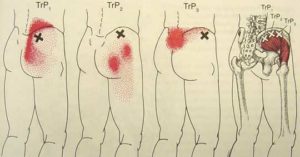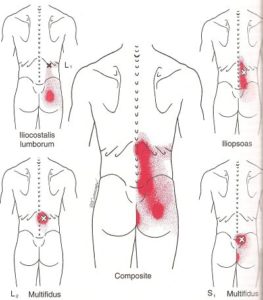Low Back Pain, The Common Causes
Needless to say, many things can cause low back pain including digestive issues, hormone imbalance, a herniated disc… But here I will discuss the most common cause- trigger points (TrPs) in surrounding muscle tissue. Yes, fascia definitely plays a part, but for simplicity’s sake, we’ll be focusing on the common TrPs that cause those aches and pains in your back.
Hopefully you had a chance to read our previous article on what to do and not to do when you have back pain because here, I’ll mainly be explaining some lovely trigger point patterns and why they occur.
Paraspinal Muscles
In this first picture, you can see each x representing a TrP and the red coloring represents the pain it causes. The paraspinal muscles (iliocostalis and multifidus pictured) extend your spine, so it’s understandable that they might develop trigger points from sitting with a curved low back (tucked pelvis).
These muscles are working against that curve to make sure you don’t collapse into yourself! You don’t feel them working at the time, but because they are lengthened and active for long periods of sitting, it’s easy for them to get aggravated.
Now if you were able to stack your spine while you sit, so that your muscles weren’t having to work, that’s where you’ll help your back out. Here’s a video on stack sitting.
Another preventative measure for decreasing back pain is strengthening your low back muscles. That way, they won’t fatigue and develop TrPs so easily.
Iliopsoas, ilio what?!
Yes, your iliopsoas, which is a part of your psoas muscle group (pronounced so-as), is usually involved in low back pain if the pain is right next to your spine and covers a few vertebrae. Even though the trigger point is pictured on the back, this muscle actually runs along the front of your spine. So treating the TrP is done by a professional massaging past your abs and organs to get to your psoas. You are not going to get anywhere trying to massage your iliopsoas from the back!
I could spend hours writing about the psoas muscle, so for now, we’ll save it for another rainy day.
Moving Onto the Hips
 The lovely gluteus medius is occasionally overlooked when it comes to low back pain. If you experience your low back pain really low, like on your sacrum or the top of your hips, chances are your gluteus medius could use some trigger point work.
The lovely gluteus medius is occasionally overlooked when it comes to low back pain. If you experience your low back pain really low, like on your sacrum or the top of your hips, chances are your gluteus medius could use some trigger point work.
The gluteus medius muscle (pictured left) is a prime candidate for a self massage using a small ball (tennis, lacrosse, racquetball..). It’s quite easy on your own to lie on your side on the ball, find a very tender spot, and hang out there for a minute or so before finding another painful, but oh so good, spot.
Sometimes the pain from gluteus medius and other glute and hip muscles (which cause pain down the leg as well), can be so excrutiating that a doctor might diagnose you with sciatica. Unless you have numbness or tingling, it’s most likely you have TrPs in your glutes, instead of true sciatica.
And as always, feel free to leave a comment or contact me if you have any questions, 801-906-3222. It’s likely I’ll be able to steer you in the right direction.
Don’t forget to get your healthy dose of massage from a specialized massage therapist. Here in Salt Lake, our massage therapists are trained in helping you relieve low back pain. So get your trigger point massage on so you can get back to cycling, skiing, hiking, or running!
And if you have been told you have arthritis or you have a propensity for inflammation, take a look at your diet. Seriously. I had a client who finally connected his left shoulder pain to eating too much sugar over the holidays. If you don’t know where to start, start with cutting sugar, processed foods, and wheat. Or you could schedule a free 30 minute Discovery Session to find out about my healthy body system to help you get out of pain, increase energy, and improve health instead of spiral into dis-ease.
Pictures courtesy of Travell & Simons’ Myofascial Pain & Dysfunction: Trigger Point Manual



Excellent piece of information for people who are suffering from back pain.
Thank you for posting!